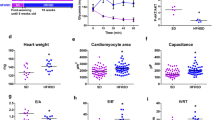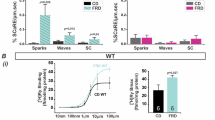Abstract
Diabetes is commonly associated with an elevated level of reactive carbonyl species due to alteration of glucose and fatty acid metabolism. These metabolic changes cause an abnormality in cardiac Ca2+ regulation that can lead to cardiomyopathies. In this study, we explored how the reactive α-dicarbonyl methylglyoxal (MGO) affects Ca2+ regulation in mouse ventricular myocytes. Analysis of intracellular Ca2+ dynamics revealed that MGO (200 μM) increases action potential (AP)-induced Ca2+ transients and sarcoplasmic reticulum (SR) Ca2+ load, with a limited effect on L-type Ca2+ channel-mediated Ca2+ transients and SERCA-mediated Ca2+ uptake. At the same time, MGO significantly slowed down cytosolic Ca2+ extrusion by Na+/Ca2+ exchanger (NCX). MGO also increased the frequency of Ca2+ waves during rest and these Ca2+ release events were abolished by an external solution with zero [Na+] and [Ca2+]. Adrenergic receptor activation with isoproterenol (10 nM) increased Ca2+ transients and SR Ca2+ load, but it also triggered spontaneous Ca2+ waves in 27% of studied cells. Pretreatment of myocytes with MGO increased the fraction of cells with Ca2+ waves during adrenergic receptor stimulation by 163%. Measurements of intracellular [Na+] revealed that MGO increases cytosolic [Na+] by 57% from the maximal effect produced by the Na+-K+ ATPase inhibitor ouabain (20 μM). This increase in cytosolic [Na+] was a result of activation of a tetrodotoxin-sensitive Na+ influx, but not an inhibition of Na+-K+ ATPase. An increase in cytosolic [Na+] after treating cells with ouabain produced similar effects on Ca2+ regulation as MGO. These results suggest that protein carbonylation can affect cardiac Ca2+ regulation by increasing cytosolic [Na+] via a tetrodotoxin-sensitive pathway. This, in turn, reduces Ca2+ extrusion by NCX, causing SR Ca2+ overload and spontaneous Ca2+ waves.






Similar content being viewed by others
Data availability
The data supporting this article and other findings are available within the manuscript, figures, and from the corresponding authors upon request.
References
Ai X, Curran JW, Shannon TR, Bers DM, Pogwizd SM (2005) Ca2+/calmodulin-dependent protein kinase modulates cardiac ryanodine receptor phosphorylation and sarcoplasmic reticulum Ca2+ leak in heart failure. Circ Res 97:1314–1322. https://doi.org/10.1161/01.RES.0000194329.41863.89
Armoundas AA, Rose J, Aggarwal R, Stuyvers BD, O’Rourke B, Kass DA, Marban E, Shorofsky SR, Tomaselli GF, William Balke C (2007) Cellular and molecular determinants of altered Ca2+ handling in the failing rabbit heart: primary defects in SR Ca2+ uptake and release mechanisms. Am J Physiol Heart Circ Physiol 292:H1607-1618. https://doi.org/10.1152/ajpheart.00525.2006
Baginski ES, Foa PP, Zak B (1967) Determnation of rat liver microsomal glucose-6-phosphatase activity: study of citrate and G-6-P inhibition. Anal Biochem 21:201–207. https://doi.org/10.1016/0003-2697(67)90181-9
Bassani JW, Bassani RA, Bers DM (1994) Relaxation in rabbit and rat cardiac cells: species-dependent differences in cellular mechanisms. J Physiol 476:279–293
Belevych AE, Terentyev D, Viatchenko-Karpinski S, Terentyeva R, Sridhar A, Nishijima Y, Wilson LD, Cardounel AJ, Laurita KR, Carnes CA, Billman GE, Gyorke S (2009) Redox modification of ryanodine receptors underlies calcium alternans in a canine model of sudden cardiac death. Cardiovasc Res 84:387–395. https://doi.org/10.1093/cvr/cvp246
Bers DM (2002) Cardiac excitation-contraction coupling. Nature 415:198–205. https://doi.org/10.1038/415198a
Bovo E, Dvornikov AV, Mazurek SR, de Tombe PP, Zima AV (2013) Mechanisms of Ca(2)+ handling in zebrafish ventricular myocytes. Pflugers Arch 465:1775–1784. https://doi.org/10.1007/s00424-013-1312-2
Bovo E, Lipsius SL, Zima AV (2012) Reactive oxygen species contribute to the development of arrhythmogenic Ca(2)(+) waves during beta-adrenergic receptor stimulation in rabbit cardiomyocytes. J Physiol 590:3291–3304. https://doi.org/10.1113/jphysiol.2012.230748
Bovo E, Mazurek SR, Zima AV (2018) Oxidation of ryanodine receptor after ischemia-reperfusion increases propensity of Ca(2+) waves during beta-adrenergic receptor stimulation. Am J Physiol Heart Circ Physiol 315:H1032–H1040. https://doi.org/10.1152/ajpheart.00334.2018
Bovo E, Nikolaienko R, Bhayani S, Kahn D, Cao Q, Martin JL, Kuo IY, Robia SL, Zima AV (2019) Novel approach for quantification of endoplasmic reticulum Ca(2+) transport. Am J Physiol Heart Circ Physiol 316:H1323–H1331. https://doi.org/10.1152/ajpheart.00031.2019
Brette F, Luxan G, Cros C, Dixey H, Wilson C, Shiels HA (2008) Characterization of isolated ventricular myocytes from adult zebrafish (Danio rerio). Biochem Biophys Res Commun 374:143–146. https://doi.org/10.1016/j.bbrc.2008.06.109
Brownlee M, Cerami A, Vlassara H (1988) Advanced products of nonenzymatic glycosylation and the pathogenesis of diabetic vascular disease. Diabetes Metab Rev 4:437–451. https://doi.org/10.1002/dmr.5610040503
Cutler MJ, Plummer BN, Wan X, Sun QA, Hess D, Liu H, Deschenes I, Rosenbaum DS, Stamler JS, Laurita KR (2012) Aberrant S-nitrosylation mediates calcium-triggered ventricular arrhythmia in the intact heart. Proc Natl Acad Sci USA 109:18186–18191. https://doi.org/10.1073/pnas.1210565109
Despa S, Islam MA, Weber CR, Pogwizd SM, Bers DM (2002) Intracellular Na(+) concentration is elevated in heart failure but Na/K pump function is unchanged. Circulation 105:2543–2548. https://doi.org/10.1161/01.cir.0000016701.85760.97
DiNello E, Bovo E, Thuo P, Martin TG, Kirk JA, Zima AV, Cao Q, Kuo IY (2020) Deletion of cardiac polycystin 2/PC2 results in increased SR calcium release and blunted adrenergic reserve. Am J Physiol Heart Circ Physiol 319:H1021–H1035. https://doi.org/10.1152/ajpheart.00302.2020
El-Armouche A, Eschenhagen T (2009) Beta-adrenergic stimulation and myocardial function in the failing heart. Heart Fail Rev 14:225–241. https://doi.org/10.1007/s10741-008-9132-8
Gaber EM, Jayaprakash P, Qureshi MA, Parekh K, Oz M, Adrian TE, Howarth FC (2014) Effects of a sucrose-enriched diet on the pattern of gene expression, contraction and Ca(2+) transport in Goto-Kakizaki type 2 diabetic rat heart. Exp Physiol 99:881–893. https://doi.org/10.1113/expphysiol.2013.077594
Galderisi M (2006) Diastolic dysfunction and diabetic cardiomyopathy: evaluation by Doppler echocardiography. J Am Coll Cardiol 48:1548–1551. https://doi.org/10.1016/j.jacc.2006.07.033
Gheorghiade M, Adams KF Jr, Colucci WS (2004) Digoxin in the management of cardiovascular disorders. Circulation 109:2959–2964. https://doi.org/10.1161/01.CIR.0000132482.95686.87
Grisanti LA (2018) Diabetes and Arrhythmias: Pathophysiology, Mechanisms and Therapeutic Outcomes. Front Physiol 9:1669. https://doi.org/10.3389/fphys.2018.01669
Guide for the Care and Use of Laboratory Animals (2011) NBK54050 [bookaccession]. https://doi.org/10.17226/12910
Horvath B, Bers DM (2014) The late sodium current in heart failure: pathophysiology and clinical relevance. ESC Heart Fail 1:26–40. https://doi.org/10.1002/ehf2.12003
Horvath B, Szentandrassy N, Almassy J, Dienes C, Kovacs ZM, Nanasi PP, Banyasz T (2022) Late Sodium Current of the Heart: Where Do We Stand and Where Are We Going? Pharmaceuticals (Basel) 15. https://doi.org/10.3390/ph15020231
Imahashi K, Kusuoka H, Hashimoto K, Yoshioka J, Yamaguchi H, Nishimura T (1999) Intracellular sodium accumulation during ischemia as the substrate for reperfusion injury. Circ Res 84:1401–1406. https://doi.org/10.1161/01.res.84.12.1401
Jelicks LA, Siri FM (1995) Effects of hypertrophy and heart failure on [Na+]i in pressure-overloaded guinea pig heart. Am J Hypertens 8:934–943. https://doi.org/10.1016/0895-7061(95)00219-F
Jorgensen PL (1988) Purification of Na+, K+-ATPase: enzyme sources, preparative problems, and preparation from mammalian kidney. Methods Enzymol 156:29–43. https://doi.org/10.1016/0076-6879(88)56005-6
Kim HW, Ch YS, Lee HR, Park SY, Kim YH (2001) Diabetic alterations in cardiac sarcoplasmic reticulum Ca2+-ATPase and phospholamban protein expression. Life Sci 70:367–379. https://doi.org/10.1016/s0024-3205(01)01483-7
Miki T, Yuda S, Kouzu H, Miura T (2013) Diabetic cardiomyopathy: pathophysiology and clinical features. Heart Fail Rev 18:149–166. https://doi.org/10.1007/s10741-012-9313-3
Papadaki M, Kampaengsri T, Barrick SK, Campbell SG, von Lewinski D, Rainer PP, Harris SP, Greenberg MJ, Kirk JA (2022) Myofilament glycation in diabetes reduces contractility by inhibiting tropomyosin movement, is rescued by cMyBPC domains. J Mol Cell Cardiol 162:1–9. https://doi.org/10.1016/j.yjmcc.2021.08.012
Picht E, Zima AV, Blatter LA, Bers DM (2007) SparkMaster: automated calcium spark analysis with ImageJ. Am J Physiol Cell Physiol 293:C1073-1081. https://doi.org/10.1152/ajpcell.00586.2006
Semchyshyn HM (2014) Reactive carbonyl species in vivo: generation and dual biological effects. Sci World J 2014:417842. https://doi.org/10.1155/2014/417842
Shao CH, Capek HL, Patel KP, Wang M, Tang K, DeSouza C, Nagai R, Mayhan W, Periasamy M, Bidasee KR (2011) Carbonylation contributes to SERCA2a activity loss and diastolic dysfunction in a rat model of type 1 diabetes. Diabetes 60:947–959. https://doi.org/10.2337/db10-1145
Shao CH, Tian C, Ouyang S, Moore CJ, Alomar F, Nemet I, D’Souza A, Nagai R, Kutty S, Rozanski GJ, Ramanadham S, Singh J, Bidasee KR (2012) Carbonylation induces heterogeneity in cardiac ryanodine receptor function in diabetes mellitus. Mol Pharmacol 82:383–399. https://doi.org/10.1124/mol.112.078352
Shao CH, Wehrens XH, Wyatt TA, Parbhu S, Rozanski GJ, Patel KP (1985) Bidasee KR (2009) Exercise training during diabetes attenuates cardiac ryanodine receptor dysregulation. J Appl Physiol 106:1280–1292. https://doi.org/10.1152/japplphysiol.91280.2008
Sweadner KJ (1989) Isozymes of the Na+/K+-ATPase. Biochim Biophys Acta 988:185–220. https://doi.org/10.1016/0304-4157(89)90019-1
Tian CJ, Zhen Z (2019) Reactive Carbonyl Species: Diabetic Complication in the Heart and Lungs. Trends Endocrinol Metab 30:546–556. https://doi.org/10.1016/j.tem.2019.05.005
Undrovinas AI, Fleidervish IA, Makielski JC (1992) Inward sodium current at resting potentials in single cardiac myocytes induced by the ischemic metabolite lysophosphatidylcholine. Circ Res 71:1231–1241. https://doi.org/10.1161/01.res.71.5.1231
Undrovinas AI, Maltsev VA, Sabbah HN (1999) Repolarization abnormalities in cardiomyocytes of dogs with chronic heart failure: role of sustained inward current. Cell Mol Life Sci 55:494–505. https://doi.org/10.1007/s000180050306
Undrovinas AI, Shander GS, Makielski JC (1995) Cytoskeleton modulates gating of voltage-dependent sodium channel in heart. Am J Physiol 269:H203-214. https://doi.org/10.1152/ajpheart.1995.269.1.H203
West JW, Numann R, Murphy BJ, Scheuer T, Catterall WA (1991) A phosphorylation site in the Na+ channel required for modulation by protein kinase C. Science 254:866–868. https://doi.org/10.1126/science.1658937
Wold LE, Dutta K, Mason MM, Ren J, Cala SE, Schwanke ML, Davidoff AJ (2005) Impaired SERCA function contributes to cardiomyocyte dysfunction in insulin resistant rats. J Mol Cell Cardiol 39:297–307. https://doi.org/10.1016/j.yjmcc.2005.03.014
Yan Y, Shapiro AP, Mopidevi BR, Chaudhry MA, Maxwell K, Haller ST, Drummond CA, Kennedy DJ, Tian J, Malhotra D, Xie ZJ, Shapiro JI, Liu J (2016) Protein Carbonylation of an Amino Acid Residue of the Na/K-ATPase alpha1 Subunit Determines Na/K-ATPase Signaling and Sodium Transport in Renal Proximal Tubular Cells. J Am Heart Assoc 5. https://doi.org/10.1161/JAHA.116.003675
Zima AV, Bovo E, Bers DM, Blatter LA (2010) Ca(2)+ spark-dependent and -independent sarcoplasmic reticulum Ca(2)+ leak in normal and failing rabbit ventricular myocytes. J Physiol 588:4743–4757. https://doi.org/10.1113/jphysiol.2010.197913
Zima AV, Bovo E, Mazurek SR, Rochira JA, Li W, Terentyev D (2014) Ca handling during excitation-contraction coupling in heart failure. Pflugers Arch 466:1129–1137. https://doi.org/10.1007/s00424-014-1469-3
Zima AV, Copello JA, Blatter LA (2004) Effects of cytosolic NADH/NAD(+) levels on sarcoplasmic reticulum Ca(2+) release in permeabilized rat ventricular myocytes. J Physiol 555:727–741. https://doi.org/10.1113/jphysiol.2003.055848
Zima AV, Kockskamper J, Mejia-Alvarez R, Blatter LA (2003) Pyruvate modulates cardiac sarcoplasmic reticulum Ca2+ release in rats via mitochondria-dependent and -independent mechanisms. J Physiol 550:765–783. https://doi.org/10.1113/jphysiol.2003.040345
Zima AV, Picht E, Bers DM, Blatter LA (2008) Termination of cardiac Ca2+ sparks: role of intra-SR [Ca2+], release flux, and intra-SR Ca2+ diffusion. Circ Res 103:e105-115. https://doi.org/10.1161/CIRCRESAHA.107.183236
Acknowledgements
The authors would like to thank Dr. L. Michel Espinoza-Fonseca (University of Michigan, USA) for assisting with preparing purified NKA.
Funding
This work was supported by the National Institutes of Health Grants R01HL151990 (to A.V.Z.) and R01 HL092321 (to S.L.R.).
Author information
Authors and Affiliations
Contributions
E.B., S.L.R. and A.V.Z. contributed to the conception and design of the study. E.B., J.S., S.L.R., and A.V.Z. performed the experimental work and analysis of results. E.B., J.S., S.L.R. and A.V.Z. contributed to the writing of the manuscript.
Corresponding author
Ethics declarations
Ethical Approval
All animal experiments were carried out in accordance with the National Institutes of Health guide for the care and use of Laboratory animals [21]. Male and female C57Bl6/J mice (Jackson Laboratories, US) were housed according to approved IACUC protocol IACUC#23–027 (Loyola University Chicago).
Competing interests
The authors declare no competing interests.
Additional information
Publisher's Note
Springer Nature remains neutral with regard to jurisdictional claims in published maps and institutional affiliations.
Rights and permissions
Springer Nature or its licensor (e.g. a society or other partner) holds exclusive rights to this article under a publishing agreement with the author(s) or other rightsholder(s); author self-archiving of the accepted manuscript version of this article is solely governed by the terms of such publishing agreement and applicable law.
About this article
Cite this article
Bovo, E., Seflova, J., Robia, S.L. et al. Protein carbonylation causes sarcoplasmic reticulum Ca2+ overload by increasing intracellular Na+ level in ventricular myocytes. Pflugers Arch - Eur J Physiol 476, 1077–1086 (2024). https://doi.org/10.1007/s00424-024-02972-7
Received:
Revised:
Accepted:
Published:
Issue Date:
DOI: https://doi.org/10.1007/s00424-024-02972-7




